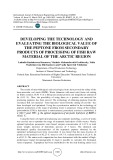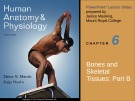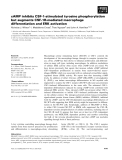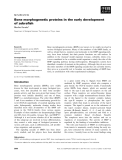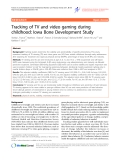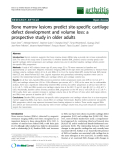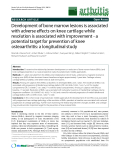
Bone development
-
In this study, salmon by-products were utilised to produce high ash content (AC) salmon bone powder (SBP) using hydrolytic enzyme and apply in the production of Tra catfish cake. The byproducts included 61.9 of moisture, 43.1 of protein, 45.4 of lipid, 10.2% of ash, 3.7 of calcium and 2.3% of phosphorus (on dry weight basis).
 7p
7p  larachdumlanat127
larachdumlanat127
 02-01-2021
02-01-2021
 15
15
 2
2
 Download
Download
-
The results of microbiological and toxicological tests have proved the safety of the bone-muscular cod waste (BMW). Waste (humerus with meat cuts) from cod cutting on fillets contains 18,95 % of a full-grade animal protein and insignificant amount of fat (0.15 %).
 14p
14p  lucastanguyen
lucastanguyen
 01-06-2020
01-06-2020
 17
17
 2
2
 Download
Download
-
AR-42, a new orally bioavailable, potent, hydroxamate-tethered phenylbutyrate class I/IIB histone deacetylase inhibitor currently is under evaluation in phase 1 and 2 clinical trials and has demonstrated activity in both hematologic and solid tumor malignancies. This report focuses on the preclinical characterization of the pharmacokinetics of AR-42 in mice and rats.
 9p
9p  caothientrangnguyen
caothientrangnguyen
 09-05-2020
09-05-2020
 18
18
 3
3
 Download
Download
-
Chapter 6: Bones and skeletal tissues (part b) provides knowledge of bone development, bone homeostasis, homeostatic imbalances of bone and developmental aspects of bones. After completing this chapter, students will be able to: Compare and contrast intramembranous ossification and endochondral ossification, describe the process of long bone growth that occurs at the epiphyseal plates,...and other contents.
 53p
53p  tangtuy07
tangtuy07
 02-04-2016
02-04-2016
 37
37
 3
3
 Download
Download
-
Macrophage colony stimulating factor (M-CSF) or CSF-1 controls the development of the macrophage lineage through its receptor tyrosine kin-ase, c-Fms. cAMP has been shown to influence proliferation and differenti-ation in many cell types, including macrophages. In addition, modulation of cellular ERK activity often occurs when cAMP levels are raised.
 12p
12p  fptmusic
fptmusic
 11-04-2013
11-04-2013
 45
45
 3
3
 Download
Download
-
The transforming growth factorb(TGF-b) superfamily includes bone mor-phogenetic proteins, activins and TGF-bsensu stricto (s.s). These ligands, which transduce their signal through a heteromeric complex of type I and type II receptors, have been shown to play a key role in numerous biologi-cal processes including early embryonic development in both deuterostomes and ecdyzozoans.
 17p
17p  fptmusic
fptmusic
 11-04-2013
11-04-2013
 26
26
 2
2
 Download
Download
-
Members of the bone morphogenetic protein (BMP) family of ligands have been identified in a variety of vertebrate and invertebrate species and have been shown to play an essential role in a range of biological processes, including mesodermal patterning and organ development, as well as the formation of bone and cartilage.
 9p
9p  galaxyss3
galaxyss3
 19-03-2013
19-03-2013
 49
49
 4
4
 Download
Download
-
Báo cáo khoa học: Bone morphogenetic protein signaling in stem cells ) one signal, many consequences
Bone morphogenetic protein (BMP) signals play key roles throughout embryology, from the earliest patterning events, via tissue specification, through organ development and again in germ cell differentiation. While both input and the transducer molecules are rather well studied, the final outcome of a BMP signal is basically unpredictable and differs enormously between previously studied cell types.
 9p
9p  galaxyss3
galaxyss3
 19-03-2013
19-03-2013
 57
57
 4
4
 Download
Download
-
Bone morphogenetic proteins (BMPs) are known to be widely involved in various biological processes. Many of the members of the BMP family, as well as related factors, receptors and molecules in the BMP signaling path-way, have been isolated, but their precise functions are still unclear.
 8p
8p  galaxyss3
galaxyss3
 19-03-2013
19-03-2013
 53
53
 3
3
 Download
Download
-
Tuyển tập các báo cáo nghiên cứu về y học được đăng trên tạp chí y học Critical Care giúp cho các bạn có thêm kiến thức về ngành y học đề tài: Tracking of TV and video gaming during childhood: Iowa Bone Development Study...
 9p
9p  coxanh_8
coxanh_8
 05-11-2011
05-11-2011
 43
43
 4
4
 Download
Download
-
Tuyển tập các báo cáo nghiên cứu về y học được đăng trên tạp chí y học General Psychiatry cung cấp cho các bạn kiến thức về ngành y đề tài: Bone marrow lesions predict site-specific cartilage defect development and volume loss: a prospective study in older adults...
 10p
10p  thulanh15
thulanh15
 21-10-2011
21-10-2011
 52
52
 4
4
 Download
Download
-
Tuyển tập các báo cáo nghiên cứu về y học được đăng trên tạp chí y học General Psychiatry cung cấp cho các bạn kiến thức về ngành y đề tài: Development of bone marrow lesions is associated with adverse effects on knee cartilage while resolution is associated with improvement - a potential target for prevention of knee osteoarthritis: a longitudinal study...
 8p
8p  thulanh14
thulanh14
 19-10-2011
19-10-2011
 50
50
 4
4
 Download
Download
-
We are constantly reminded by health professionals that excessive intake of dietary sodium is linked to hypertension, which is one of the risk factors for the development of cardiovascular disease (CVD) and stroke. They further warn you that excess sodium intake is linked to gastric cancer, decreased bone density, and obesity. That's a fact. If I have to lower my sodium intake, it's not because of CVD or hypertension since I cannot see and feel those silent diseases but rather because of obesity. Good grief, that’s noticeable and I believe in "phát tướng phát bệnh". ...
 4p
4p  genius111
genius111
 26-04-2011
26-04-2011
 69
69
 2
2
 Download
Download
-
Myelodysplasia: Treatment The therapy of MDS has been unsatisfactory. Only stem cell transplantation offers cure: survival rates of 50% at 3 years have been reported, but older patients are particularly prone to develop treatment-related mortality and morbidity. Results of transplant using matched unrelated donors are comparable, although most series contain younger and more highly selected cases.
 8p
8p  thanhongan
thanhongan
 07-12-2010
07-12-2010
 74
74
 5
5
 Download
Download
-
Aplastic Anemia Definition Aplastic anemia is pancytopenia with bone marrow hypocellularity. Acquired aplastic anemia is distinguished from iatrogenic marrow aplasia, marrow hypocellularity after intensive cytotoxic chemotherapy for cancer. Aplastic anemia can also be constitutional: the genetic diseases Fanconi's anemia and dyskeratosis congenita, while frequently associated with typical physical anomalies and the development of pancytopenia early in life, can also present as marrow failure in normal-appearing adults.
 6p
6p  thanhongan
thanhongan
 07-12-2010
07-12-2010
 85
85
 4
4
 Download
Download
-
Harrison's Internal Medicine Chapter 100. Megaloblastic Anemias Megaloblastic Anemias: Introduction The megaloblastic anemias are a group of disorders characterized by the presence of distinctive morphologic appearances of the developing red cells in the bone marrow. The cause is usually deficiency of either cobalamin (vitamin B 12) or folate, but megaloblastic anemia may arise because of genetic or acquired abnormalities affecting the metabolism of these vitamins or because of defects in DNA synthesis not related to cobalamin or folate (Table 100-1).
 5p
5p  thanhongan
thanhongan
 07-12-2010
07-12-2010
 62
62
 4
4
 Download
Download
-
Estrogen receptors (ERs) and androgen receptors, members of the steroid hormone family of nuclear receptors, are targets of inhibition by drugs used to treat breast and prostate cancers, respectively. Tamoxifen, a partial agonist and antagonist of ER function, can mediate tumor regression in metastatic breast cancer and can prevent disease recurrence in the adjuvant setting, saving thousands of lives each year. Tamoxifen binds to the ER and modulates its transcriptional activity, inhibiting activity in the breast but promoting activity in bone and uterine epithelium.
 5p
5p  konheokonmummim
konheokonmummim
 03-12-2010
03-12-2010
 78
78
 5
5
 Download
Download
-
Chemoprevention of Breast Cancer Hormonal manipulation is being tested in the primary prevention of breast cancer. Tamoxifen is an antiestrogen with partial estrogen agonistic activity in some tissues, such as endometrium and bone. One of its actions is to upregulate transforming growth factor β, which decreases breast cell proliferation. In randomized placebo-controlled trials to assess tamoxifen as adjuvant therapy for breast cancer, tamoxifen reduced the number of new breast cancers in the opposite breast by more than a third.
 5p
5p  konheokonmummim
konheokonmummim
 03-12-2010
03-12-2010
 74
74
 4
4
 Download
Download
-
Developmental Biology of Hematopoietic Stem Cells During development, blood cells are produced at different sites. Initially, the yolk sac provides oxygen-carrying red blood cells, and then several sites of intraembryonic blood cell production become involved. These intraembryonic sites engage in sequential order, moving from the genital ridge at a site where the aorta, gonadal tissue, and mesonephros are emerging to the fetal liver and then, in the second trimester, to the bone marrow and spleen.
 5p
5p  konheokonmummim
konheokonmummim
 03-12-2010
03-12-2010
 75
75
 8
8
 Download
Download
CHỦ ĐỀ BẠN MUỐN TÌM









